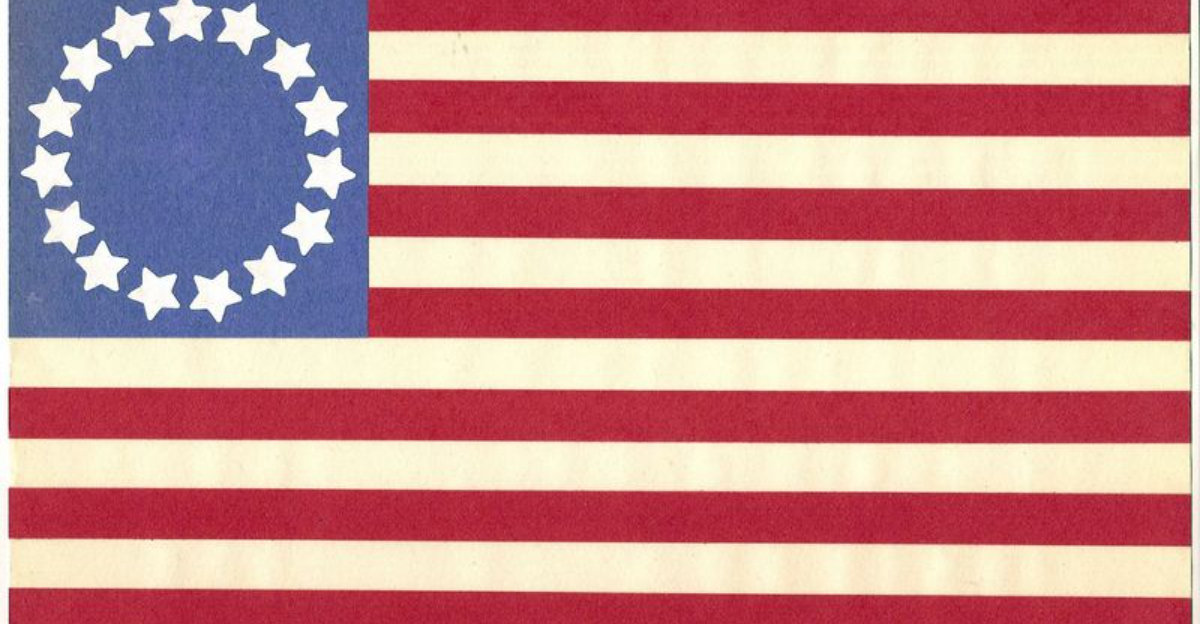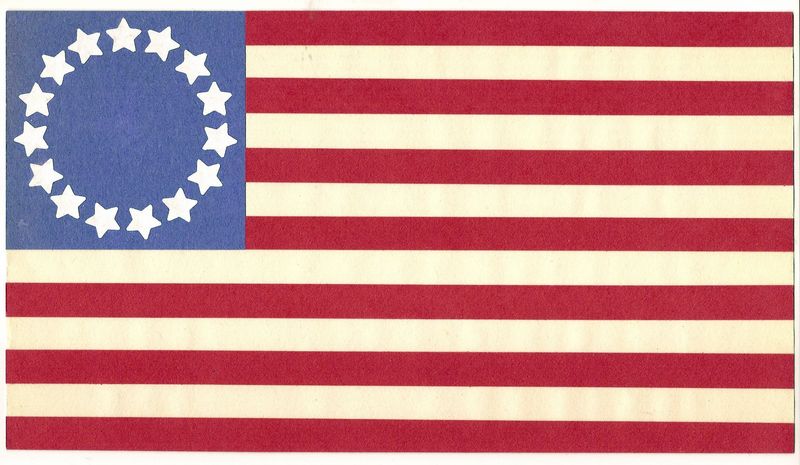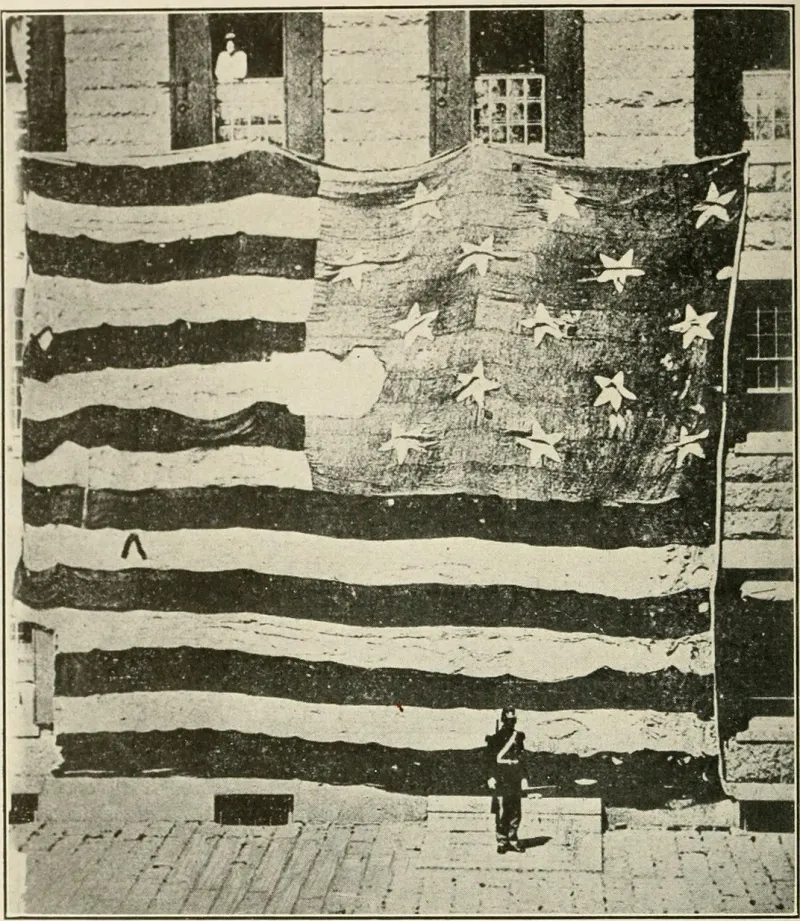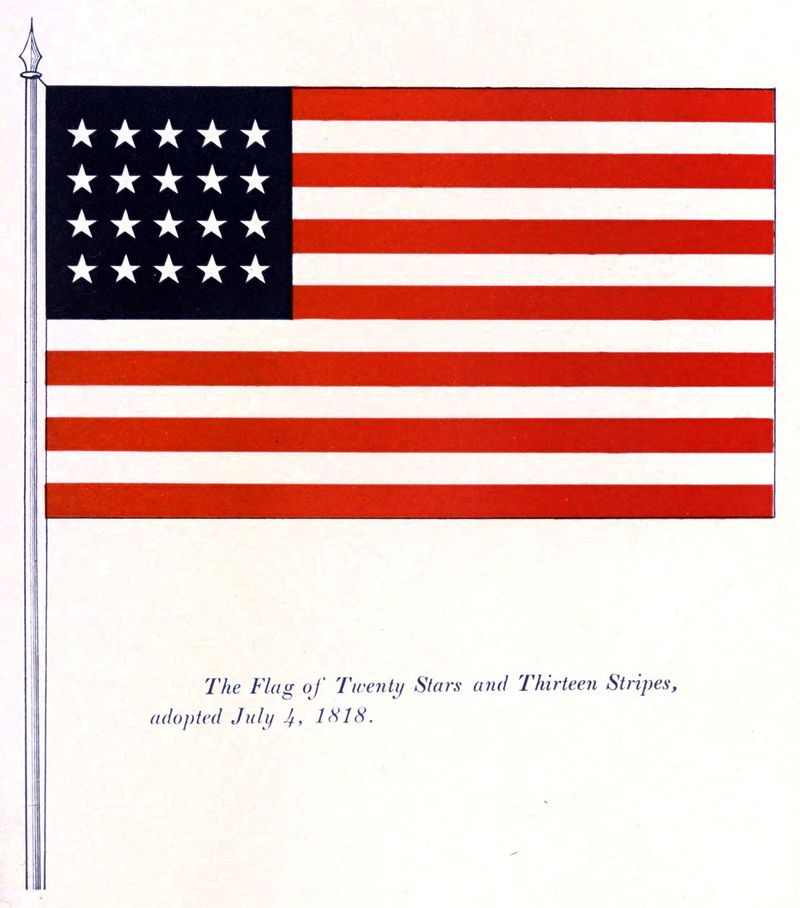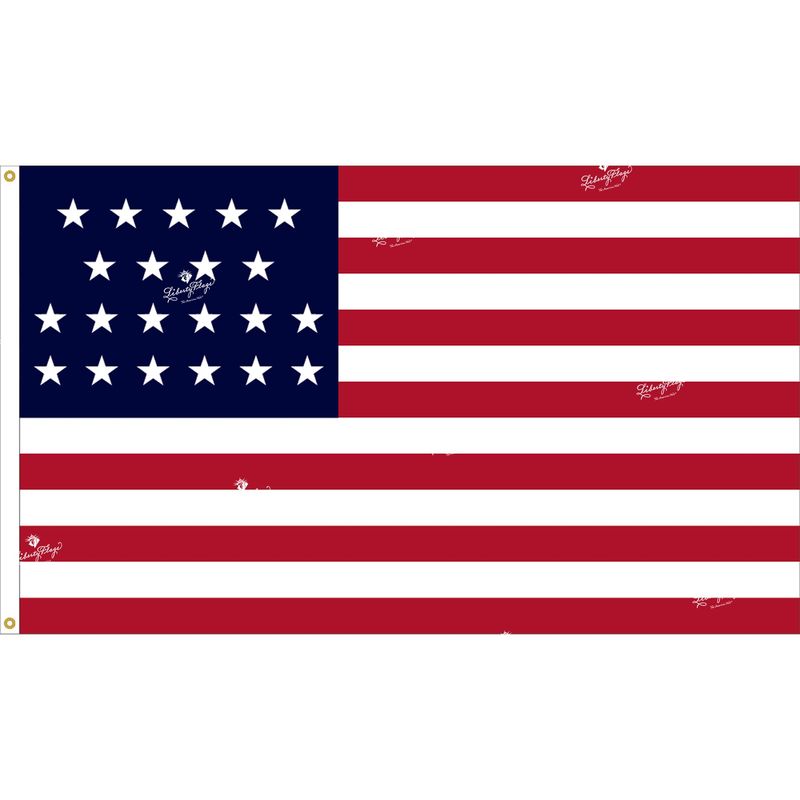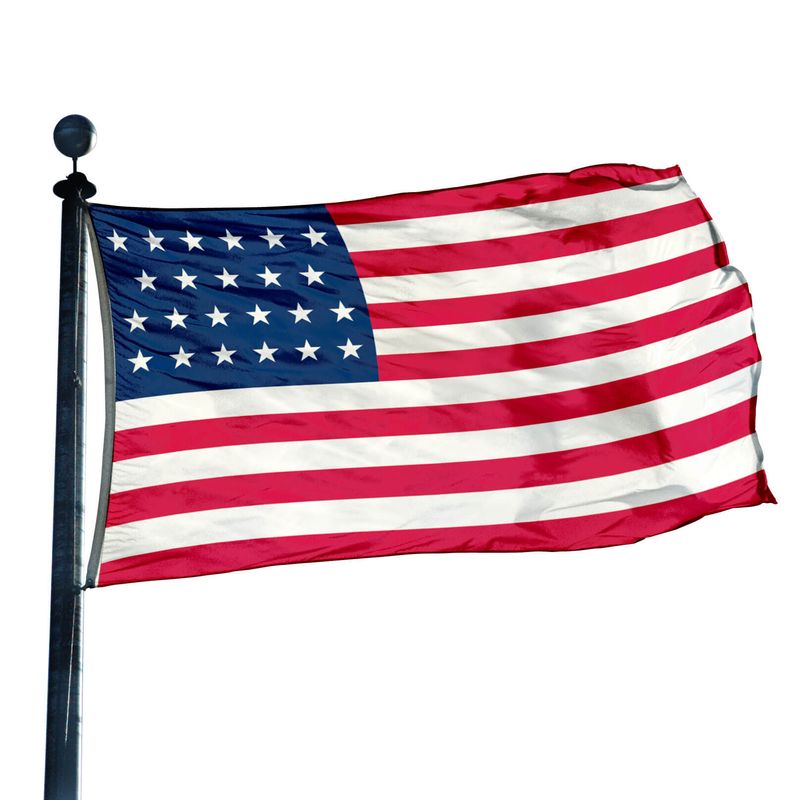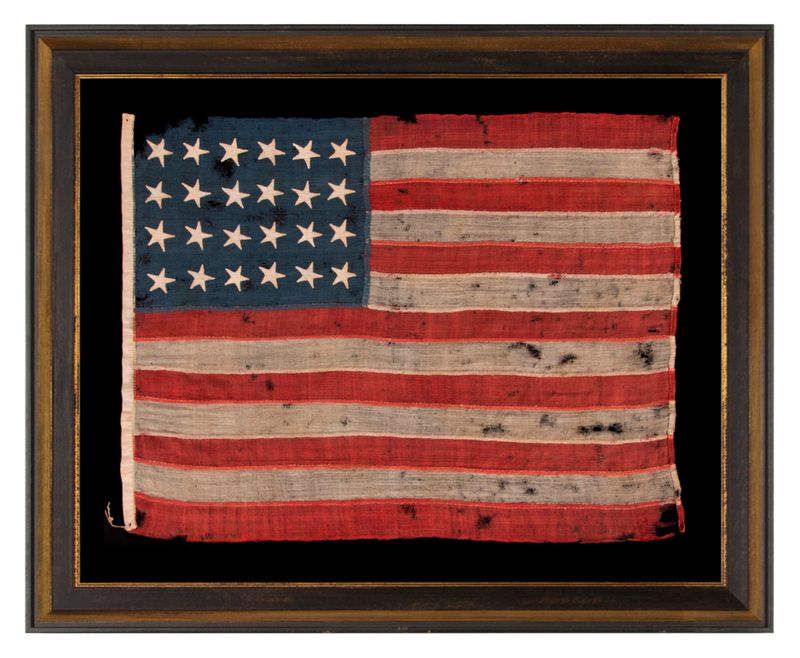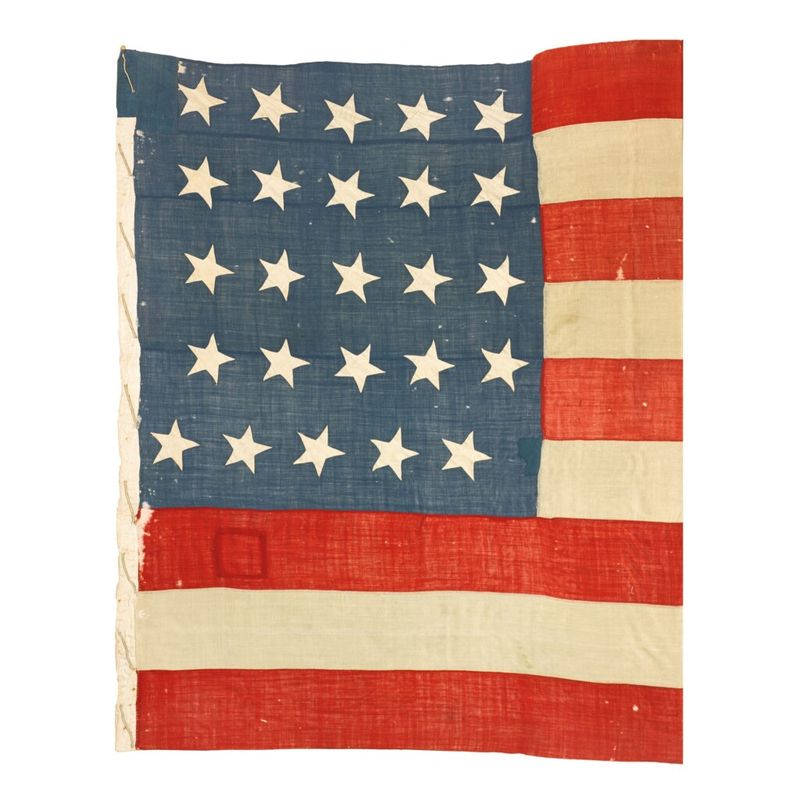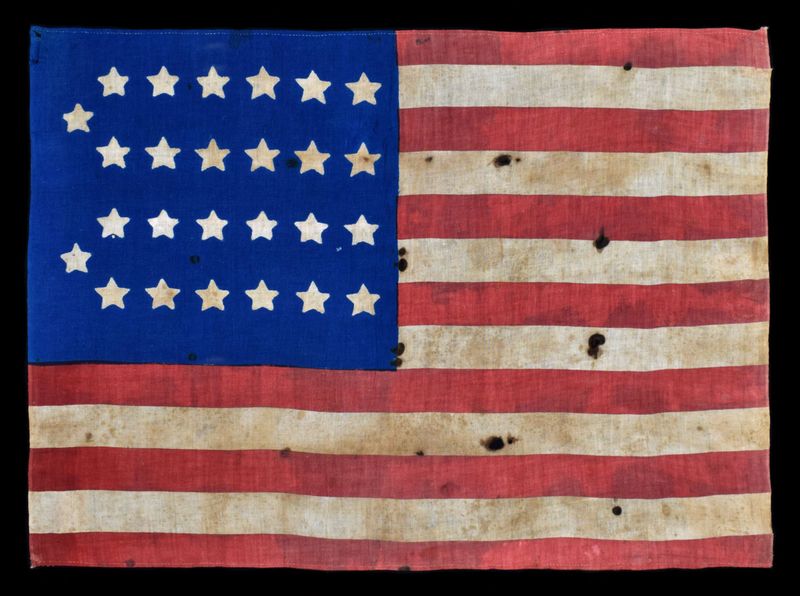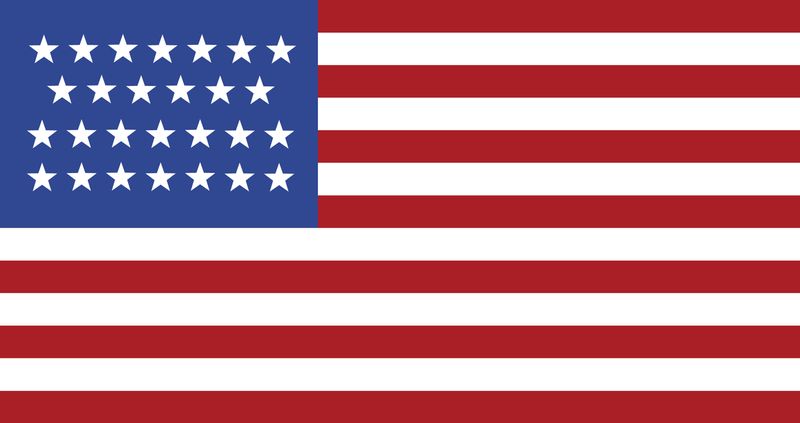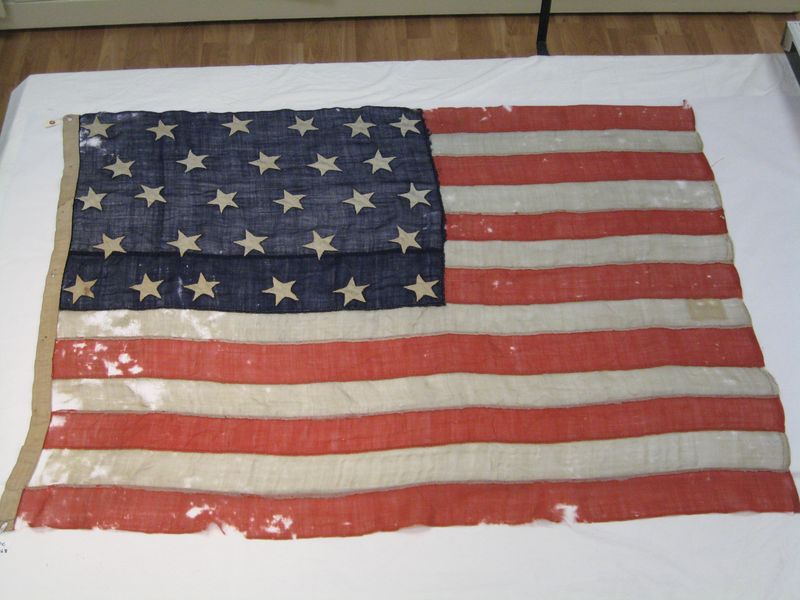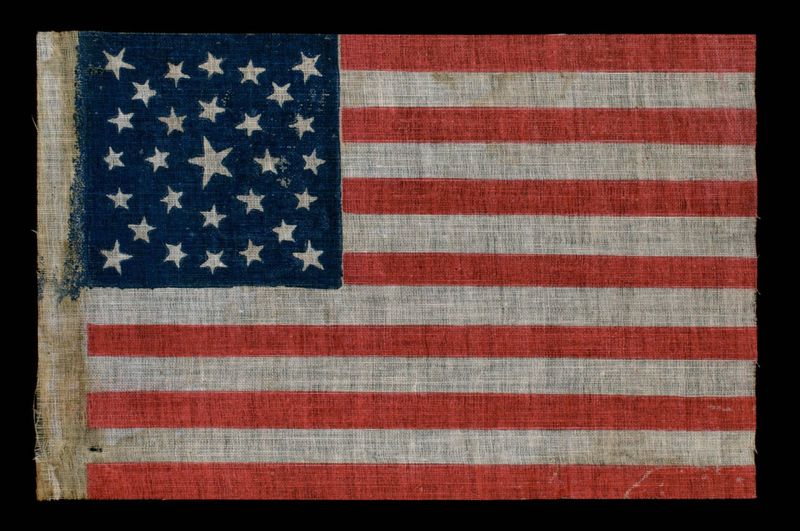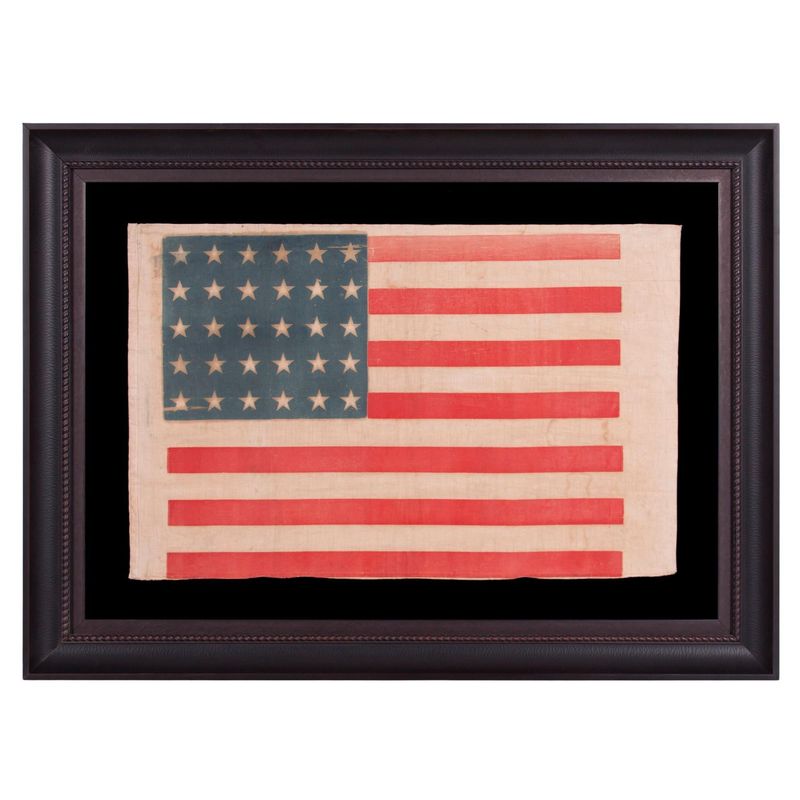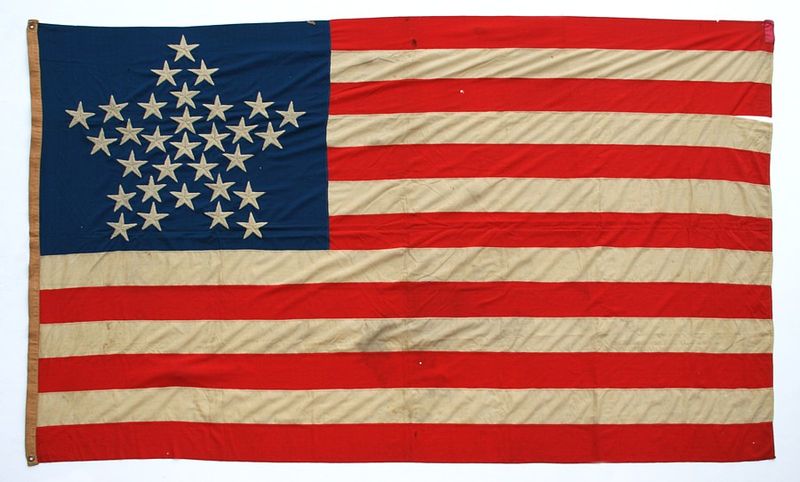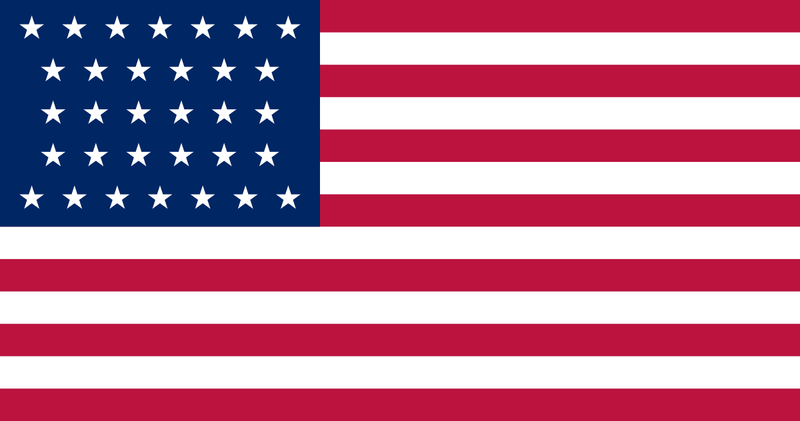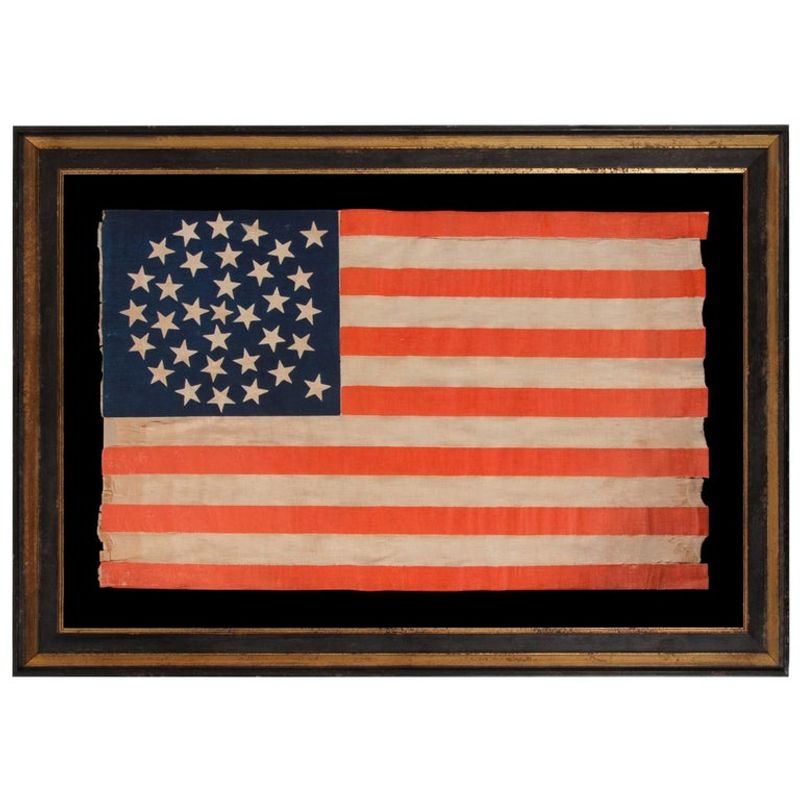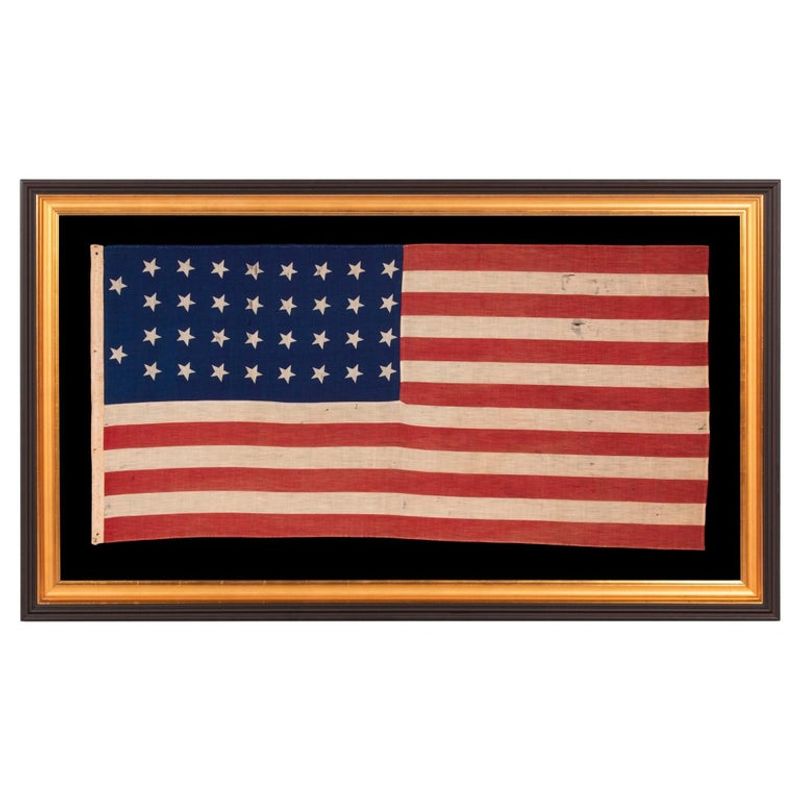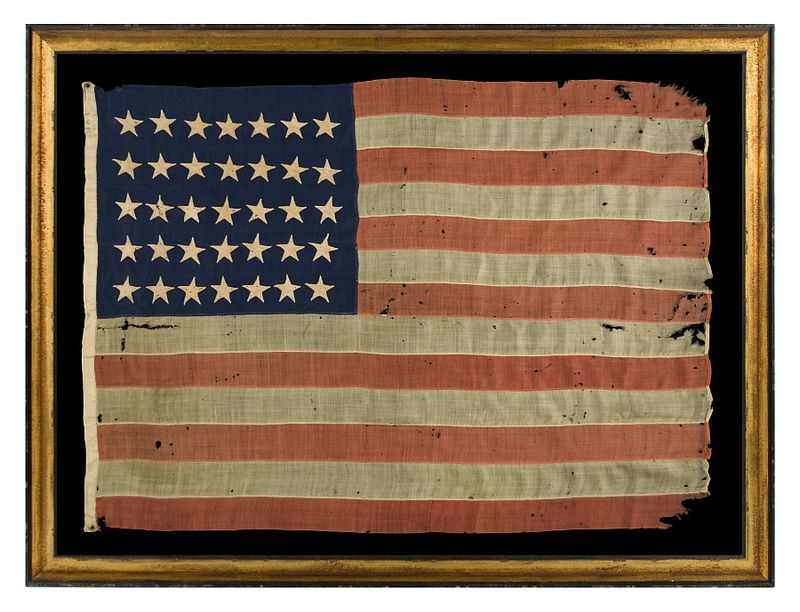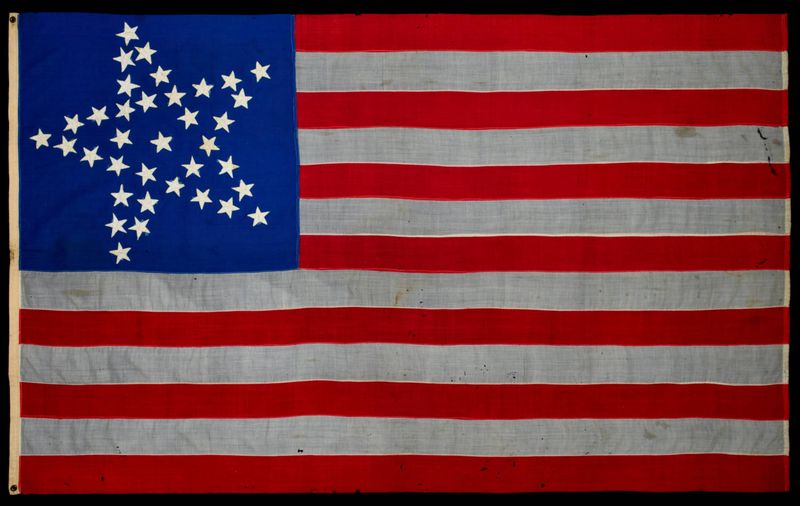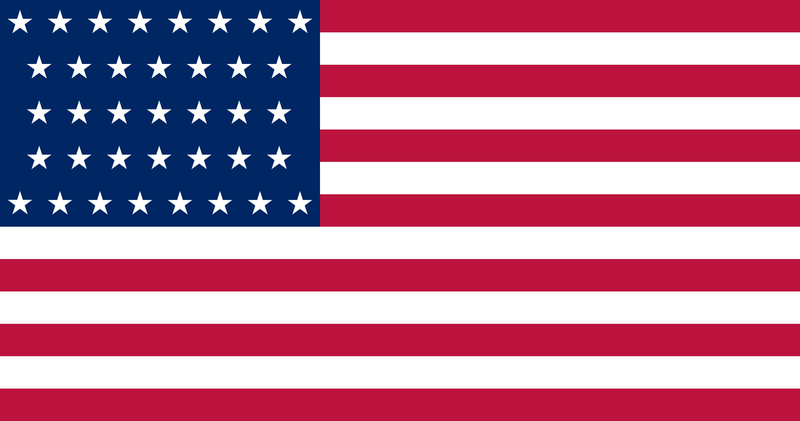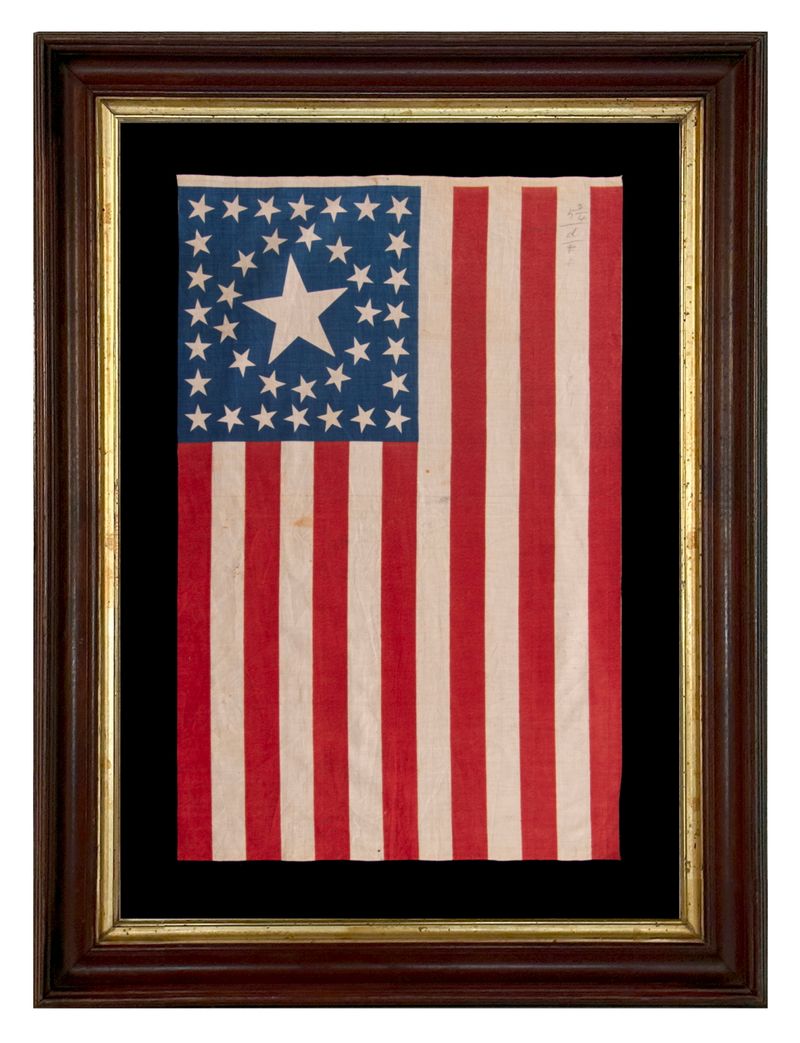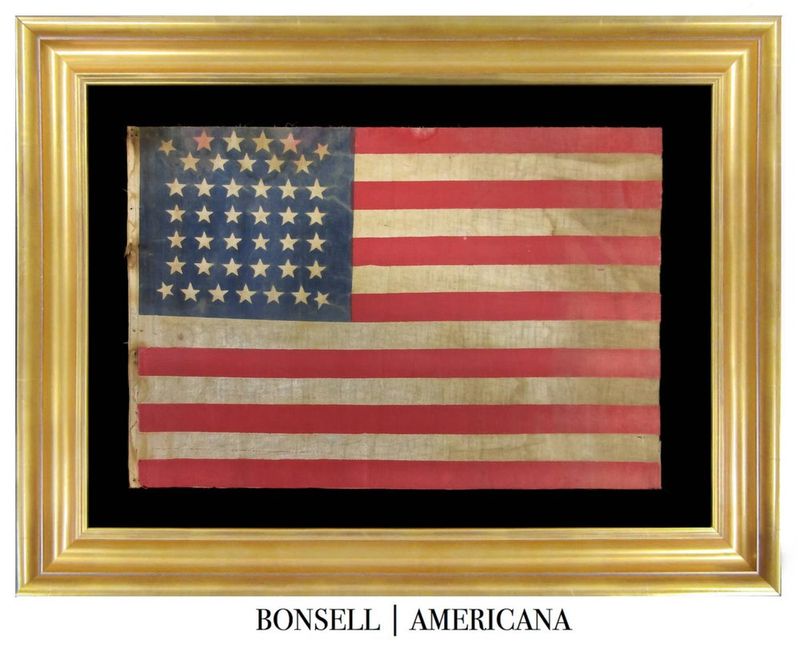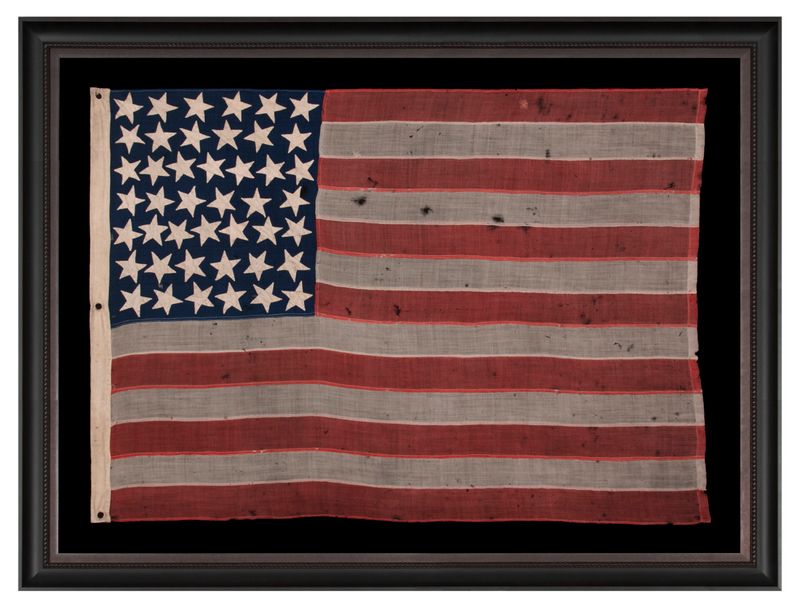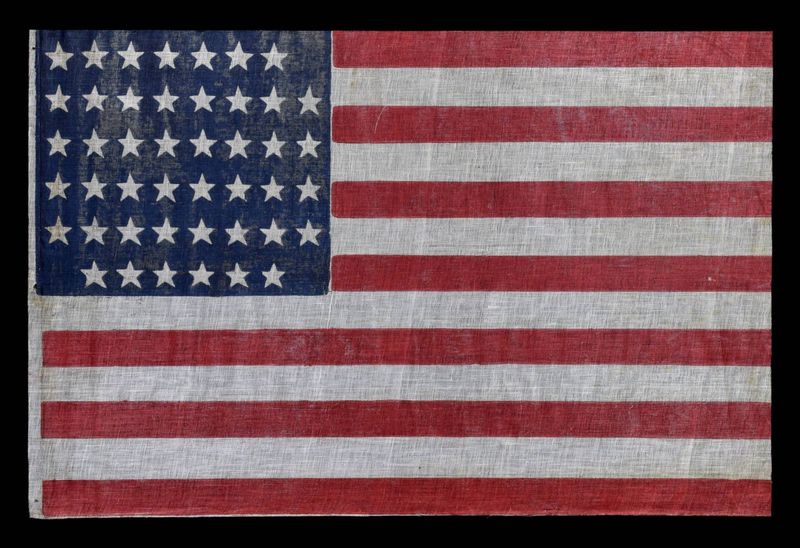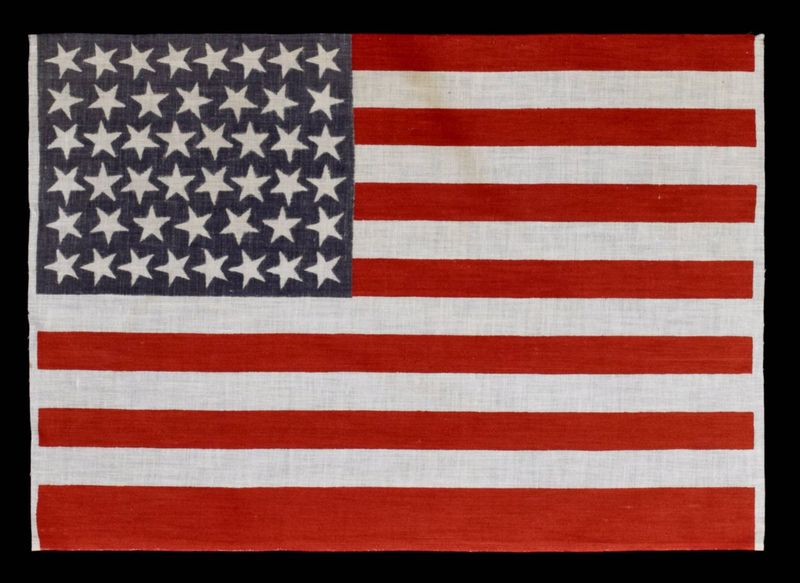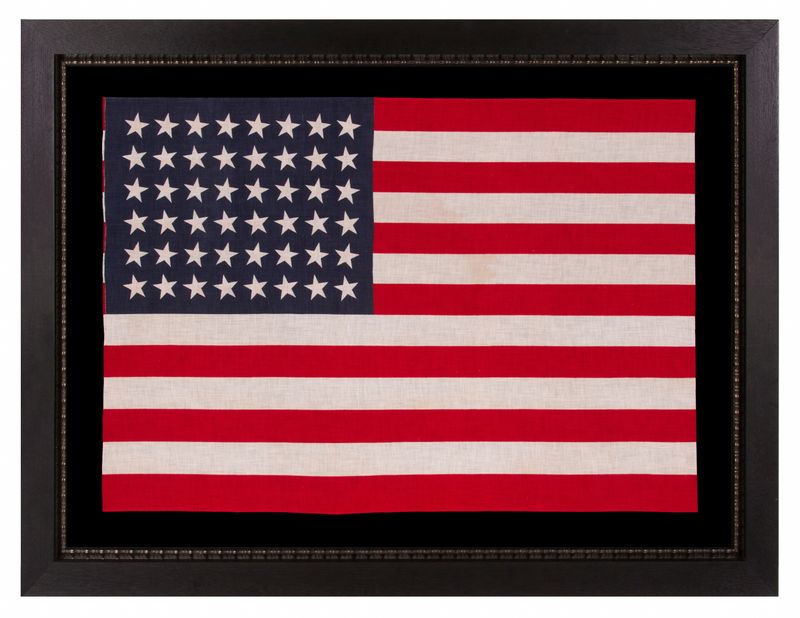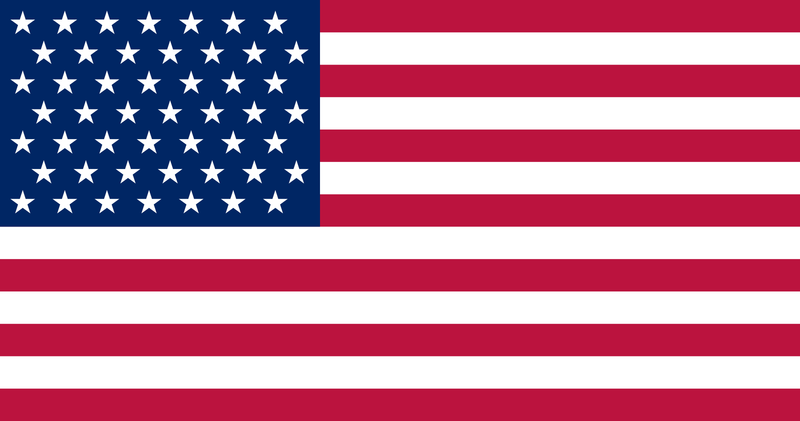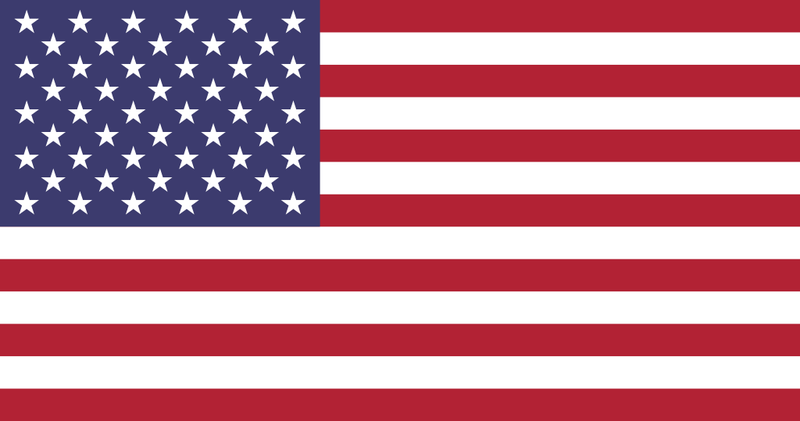The American flag stands as one of our nation’s most powerful symbols. Since 1777, this emblem of freedom has changed 27 times, with each new design marking the growth of our country. As states joined the Union, stars were added to the blue field while the 13 stripes remained a constant reminder of our original colonies.
1. The Original Stars and Stripes (1777)
Congress officially adopted our first national flag on June 14, 1777. The resolution called for thirteen alternating red and white stripes and thirteen white stars on a blue field, representing the original colonies that declared independence.
Nobody knows for certain who designed this historic banner. While Betsy Ross is often credited in popular legend, historical evidence points to Francis Hopkinson, a signer of the Declaration of Independence, as a likely contributor to the design.
2. The Star-Spangled Banner Flag (1795)
When Vermont and Kentucky joined the Union, Congress approved a new flag with fifteen stars and fifteen stripes. This version flew over Fort McHenry during the Battle of Baltimore in 1814, inspiring Francis Scott Key to write our national anthem.
The extra-large garrison flag measured 30 by 42 feet—massive even by today’s standards! Its visibility through the smoke of battle gave proof that American forces had withstood the British bombardment.
3. Return to Thirteen Stripes (1818)
As more states joined the Union, adding a stripe for each became impractical. Captain Samuel C. Reid suggested keeping thirteen stripes to honor the original colonies while adding stars for new states.
Congress agreed, passing the Flag Act of 1818. This law established that the flag would always have thirteen stripes and one star for each state, with new stars added on July 4th following a state’s admission.
4. Illinois Joins the Union (1819)
Illinois became our nation’s 21st state on December 3, 1818, adding another star to the flag. The new 21-star banner became official on July 4, 1819, following the pattern established by the Flag Act.
Flag makers arranged these stars in various patterns since no official design was specified. Some created neat rows while others formed the stars into larger star shapes or circles.
This flag flew during the presidency of James Monroe as America expanded westward.
5. Two New States, Two New Stars (1820)
Alabama and Maine joined the Union within weeks of each other. Alabama became the 22nd state on December 14, 1819, while Maine followed as the 23rd on March 15, 1820.
The resulting 23-star flag became official on July 4, 1820. This version flew during a time of growing tensions over slavery, highlighted by the Missouri Compromise that same year.
The flag’s stars were commonly arranged in four rows with some containing six stars and others five.
6. Missouri Makes Twenty-Four (1822)
Missouri’s admission to the Union added the 24th star to our national flag. After much debate over whether it would enter as a slave or free state, the Missouri Compromise allowed its entry as a slave state while Maine entered as a free state.
The 24-star flag became official on July 4, 1822, and would fly for fourteen years—one of the longer-lasting designs in our flag’s history.
Many flag makers arranged these stars in a neat grid of four rows with six stars each.
7. Arkansas Expands the Union (1836)
Arkansas joined as the 25th state on June 15, 1836, during Andrew Jackson’s presidency. The new 25-star flag became official on July 4, 1836, and remained our national banner for just one year.
Flag makers typically arranged these stars in alternating rows of 4, 5, 4, 5, and 7 stars. The nation was expanding rapidly westward, with the Republic of Texas declaring independence from Mexico that same year.
This flag flew during the final months of Jackson’s presidency and the beginning of Martin Van Buren’s term.
8. Michigan Pushes Westward (1837)
Michigan became the 26th state on January 26, 1837, after resolving a border dispute with Ohio. The resulting 26-star flag became official on July 4, 1837, during Martin Van Buren’s presidency.
This flag flew during a time of economic hardship known as the Panic of 1837. Despite financial troubles, American settlers continued pushing westward, with Michigan representing the growing northwestern frontier.
Flag makers typically arranged these stars in alternating rows with different numbers in each row.
9. Florida Becomes the 27th State (1845)
Florida joined the Union on March 3, 1845, after years as a Spanish colony and later a U.S. territory. The 27-star flag became official on July 4, 1845, marking America’s continued expansion southward.
This flag had an unusually short official life of just one year. President James K. Polk flew this banner during a time of growing tension with Mexico and Britain over territorial expansion.
The stars were typically arranged in three rows of nine or alternating rows of different lengths.
10. The Lone Star State Joins (1846)
Texas officially became the 28th state on December 29, 1845, after existing as an independent republic for nearly a decade. The new 28-star flag became official on July 4, 1846, just as the Mexican-American War began.
President James K. Polk pursued the war partly to secure Texas and expand American territory westward. The stars on this flag were often arranged in four neat rows of seven stars each.
This design lasted only one year before another state joined the rapidly expanding Union.
11. Iowa Expands the Heartland (1847)
Iowa joined the Union as the 29th state on December 28, 1846. The new 29-star flag became official on July 4, 1847, while the Mexican-American War continued to rage.
This odd-numbered star count presented a challenge for flag makers seeking symmetrical designs. Some arranged the stars in concentric circles, while others created rows with different numbers of stars in each.
American forces captured Mexico City in September 1847, essentially winning the war during this flag’s brief one-year period of official use.
12. Wisconsin Makes Thirty (1848)
Wisconsin became the 30th state on May 29, 1848. The 30-star flag became official on July 4, 1848, the same year gold was discovered in California, triggering the famous Gold Rush.
This flag flew during Zachary Taylor’s presidential campaign and election. As a military hero from the Mexican-American War, Taylor campaigned under this banner.
The 30 stars were typically arranged in five rows of six stars each, creating a neat rectangular pattern that pleased the eye with its symmetry.
13. California Gold Rush Flag (1851)
California joined the Union on September 9, 1850, as part of the Compromise of 1850. The new 31-star flag became official on July 4, 1851, during Millard Fillmore’s presidency.
This flag flew as thousands rushed to California seeking fortune in the Gold Rush. The odd number of stars again challenged flag makers, who created various arrangements including a “Great Star” pattern where the stars formed one large star.
This design lasted seven years—one of the longer-serving flags in our nation’s history.
14. Minnesota’s Northern Star (1858)
Minnesota joined the Union as the 32nd state on May 11, 1858. The new 32-star flag became official on July 4, 1858, during James Buchanan’s presidency as tensions over slavery intensified.
This flag flew for just one year before Oregon’s admission would add another star. Flag makers typically arranged these stars in four rows of eight, creating a perfect rectangle.
The nation stood on the brink of civil war, with the Lincoln-Douglas debates occurring the same year this flag became official.
15. Oregon Trails West (1859)
Oregon joined as the 33rd state on February 14, 1859. The new 33-star flag became official on July 4, 1859, just before Abraham Lincoln’s election and the secession crisis.
This flag flew during John Brown’s raid on Harpers Ferry and the intensifying national debate over slavery. The odd number of stars led to various arrangements, including concentric circles or alternating rows.
Many Americans traveled to Oregon via the famous Oregon Trail during the decades before statehood, establishing American presence in the Pacific Northwest.
16. Kansas and the Coming Storm (1861)
Kansas joined the Union as a free state on January 29, 1861, after years of violent conflict between pro-slavery and anti-slavery settlers. The 34-star flag became official on July 4, 1861, after the Civil War had already begun at Fort Sumter.
This flag flew throughout most of the Civil War despite Southern states having seceded. The federal government never recognized the Confederacy’s legitimacy, so stars for all states remained on the flag.
President Lincoln insisted on preserving the Union under this banner.
17. West Virginia Splits from Virginia (1863)
West Virginia separated from Virginia and joined the Union as the 35th state on June 20, 1863. The new 35-star flag became official on July 4, 1863, immediately following the pivotal Battle of Gettysburg.
This flag represented the first time a new state formed from an existing state without that state’s consent. The western counties of Virginia remained loyal to the Union while the rest of Virginia seceded.
President Lincoln approved West Virginia’s statehood application despite constitutional questions about the process.
18. Nevada’s Silver Star (1865)
Nevada joined the Union as the 36th state on October 31, 1864. The new 36-star flag became official on July 4, 1865, shortly after the Civil War ended and President Lincoln’s assassination.
Nevada gained statehood partly due to its rich silver deposits and its support for the Union cause. President Lincoln pushed for Nevada’s admission to help secure passage of the 13th Amendment abolishing slavery.
This flag flew during the early Reconstruction period as the nation began healing from four years of devastating conflict.
19. Nebraska Joins the Rebuilt Union (1867)
Nebraska became the 37th state on March 1, 1867. The new 37-star flag became official on July 4, 1867, during Andrew Johnson’s presidency and the ongoing Reconstruction era.
This flag flew as America purchased Alaska from Russia that same year. The nation was rebuilding after the Civil War while expanding its territory and influence.
Flag makers typically arranged these stars in rows of different lengths or concentric circles. This design remained official for ten years—one of the longer-serving flags.
20. Colorado’s Centennial Star (1877)
Colorado joined the Union as the 38th state on August 1, 1876—exactly one hundred years after the Declaration of Independence. This timing earned Colorado the nickname “The Centennial State.”
The 38-star flag became official on July 4, 1877, during Rutherford B. Hayes’ presidency. This flag flew during the end of Reconstruction and the beginning of the Gilded Age, a period of rapid industrialization and economic growth.
This design remained official for thirteen years, witnessing America’s transformation into an industrial powerhouse.
21. The Dakotas, Montana, Washington, and Idaho (1890)
In 1889-1890, five states joined the Union in rapid succession: North Dakota, South Dakota, Montana, and Washington in 1889, followed by Idaho in 1890. This unprecedented growth added five stars at once!
The 43-star flag became official on July 4, 1890, during Benjamin Harrison’s presidency. This dramatic expansion came as the frontier officially closed, according to the 1890 census.
Flag makers struggled with arranging 43 stars symmetrically, creating various patterns including six rows with alternating star counts.
22. Wyoming Brings Equality (1891)
Wyoming joined the Union as the 44th state on July 10, 1890. Known as the “Equality State,” Wyoming was the first to grant women the right to vote, doing so as a territory in 1869.
The 44-star flag became official on July 4, 1891, continuing Benjamin Harrison’s presidency. This flag flew during a time of growing industrialization, immigration, and labor unrest across America.
The stars were typically arranged in rows of different lengths, creating a balanced rectangular pattern despite the even number.
23. Utah Completes the Continental West (1896)
Utah joined the Union as the 45th state on January 4, 1896. The Mormon pioneers had settled the territory decades earlier, but statehood was delayed until the church officially ended polygamy.
The 45-star flag became official on July 4, 1896, during Grover Cleveland’s presidency. This flag flew during the Spanish-American War and America’s emergence as a world power.
With Utah’s admission, the continental western states were complete, marking the end of an era of westward expansion that had defined American growth for a century.
24. Oklahoma’s Indian Territory (1908)
Oklahoma joined the Union as the 46th state on November 16, 1907. Previously known as Indian Territory, Oklahoma became home to many Native American tribes forcibly relocated there during the 19th century.
The 46-star flag became official on July 4, 1908, during Theodore Roosevelt’s presidency. This flag flew during America’s Progressive Era, when reforms addressed problems created by rapid industrialization.
Flag makers typically arranged these stars in alternating rows of seven and eight stars each.
25. New Mexico and Arizona Complete the Continental States (1912)
New Mexico and Arizona joined the Union in 1912 as the 47th and 48th states. The resulting 48-star flag became official on July 4, 1912, during William Howard Taft’s presidency.
This symmetrical design featured six rows of eight stars each. The perfect rectangle pleased flag makers and citizens alike with its balanced appearance.
This version would become one of the longest-serving designs, flying for 47 years through two World Wars, the Great Depression, and the beginning of the Cold War.
26. Alaska’s Frontier Star (1959)
Alaska joined the Union as the 49th state on January 3, 1959. The largest state by area, Alaska was purchased from Russia in 1867 but remained a territory for over 90 years.
The 49-star flag became official on July 4, 1959, during Dwight D. Eisenhower’s presidency. This unusual design featured seven rows of seven stars each, creating a square pattern.
This flag had one of the shortest official lives, flying for just one year before Hawaii’s admission added the 50th star.
27. Hawaii Completes the Current Flag (1960)
Hawaii became the 50th state on August 21, 1959. The current 50-star flag became official on July 4, 1960, during Eisenhower’s presidency.
This design features five rows of six stars alternating with four rows of five stars. Executive Order 10834 established the precise measurements and proportions of the flag we use today.
Our current flag has flown for over 60 years—the longest-serving version in American history. It has witnessed the Civil Rights Movement, the Space Race, the Digital Revolution, and countless other historic events.
